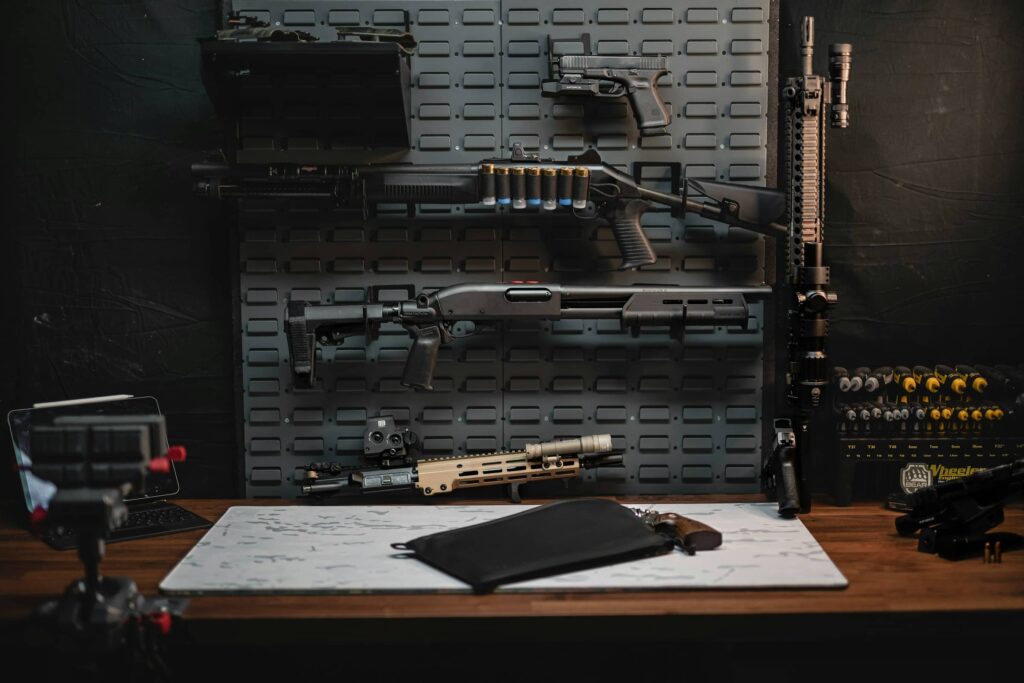How did a law introduced nearly four decades ago continue to shape American gun rights today?
The Firearms Owners Protection Act (FOPA) of 1986 remains pivotal in understanding modern gun legislation. This Act not only reformed outdated regulations but also set the stage for ongoing debates about gun rights and public safety. Unraveling the historical significance of this legislation reveals its positive impacts, which include safeguarding lawful gun ownership and streamlining federal oversight. This post provides a great overview of FOPA’s main objectives and enduring influence.
Table of Contents
Overview of the Firearms Owners Protection Act
The Firearms Owners Protection Act (FOPA) of 1986, sometimes called the McClure-Volkmer Act, was a landmark reform in U.S. gun legislation.
Enacted on May 19, 1986, it was the first major overhaul of federal firearm laws since the Gun Control Act of 1968. FOPA aimed to address issues surrounding gun ownership, particularly in the context of transportation and sales. Its goal was to correct perceived abuses by federal agencies, notably the Bureau of Alcohol, Tobacco, and Firearms (ATF), which was accused of overzealous enforcement against gun dealers. The Act introduced measures to protect gun owners’ rights while ensuring lawful firearm commerce.
FOPA’s significance lies in its ability to balance gun rights with regulatory oversight. It made significant changes to existing laws, such as limiting ATF inspections of gun dealers and preventing the establishment of a national registry of firearm owners.
This legislation had a profound impact on the legal landscape, reinforcing the protection of gun owners’ rights across the United States. By addressing federal overreach and clarifying regulations, FOPA has played a pivotal role in shaping modern U.S. gun laws, ensuring that responsible gun ownership and commerce are safeguarded.
Key goals and provisions:
- Protect gun owners from excessive federal oversight.
- Allow interstate transportation of firearms under specific conditions.
- Limit ATF inspections to once a year without probable cause.
- Prevent the creation of a national firearm registry.
- Redefine what constitutes “engaging in the business” of firearm sales.
Legislative History and Context of FOPA

Before the enactment of the FOPA in 1986, the framework of U.S. gun legislation was largely shaped by two pivotal laws: the National Firearms Act of 1934 and the Gun Control Act of 1968. The National Firearms Act primarily aimed to curb the use of automatic weapons and sawed-off shotguns by imposing stringent taxes and regulations. Meanwhile, the Gun Control Act of 1968 expanded federal control over firearms sales and ownership, setting age restrictions and prohibiting certain individuals from purchasing guns. These laws established the foundation for future legislation but also led to concerns over federal overreach.
The introduction of FOPA was largely influenced by the National Rifle Association (NRA) and other stakeholders. These groups raised concerns about the ATF, alleging that it was harassing Federal Firearms License (FFL) holders. The NRA played a crucial role in lobbying for changes and garnering public support. Their efforts focused on protecting the Second Amendment rights of citizens and ensuring fair treatment of gun dealers. The collaboration of various stakeholders was key in drafting a bill that aimed to address these grievances while maintaining public safety.
The passage of FOPA was not without its challenges and controversies. Critics argued that the Act would weaken gun control and potentially increase crime rates. There were heated debates in Congress about balancing individual rights with public safety. Despite opposition from some law enforcement agencies and gun control advocates, FOPA was eventually passed, marking a significant shift in the legislative landscape.
The Act reflected a compromise between protecting gun rights and addressing regulatory overreach, which was a hot issue at the time.
| Legislative Act | Year Enacted | Primary Purpose |
|---|---|---|
| National Firearms Act | 1934 | Regulate automatic weapons and impose taxes |
| Gun Control Act | 1968 | Expand control over sales and ownership, set restrictions |
| Firearms Owners Protection Act | 1986 | Address ATF enforcement and protect gun owners’ rights |
Key Provisions of the Firearms Owners Protection Act
What is the “safe passage” provision?
The “safe passage” provision allows lawful gun owners to transport firearms across state lines, provided the firearms are legal in both the departure and arrival states, and remain unloaded and inaccessible during transit.
This provision is important for gun owners traveling through states with varying gun laws. It ensures that responsible gun owners are not unduly penalized when obeying the law. This protection under FOPA enhances the ability of gun owners to exercise their rights without fear of legal repercussions while traveling.
How did FOPA change ATF inspections?
FOPA limited ATF inspections of gun dealers to once a year, unless they have a warrant or evidence of multiple violations. This restriction aimed to prevent the ATF from using its regulatory authority to intimidate or harass gun dealers. By reducing the frequency of inspections, FOPA sought to create a more hospitable environment for gun commerce, ensuring that dealers can operate without the constant threat of punitive inspections. This provision also aims to protect legitimate businesses from excessive regulatory paperwork.
Did FOPA create a national gun registry?
No, FOPA explicitly prohibited the creation of a national registry of gun owners. By restricting the federal government from maintaining a centralized database, the Act bolstered privacy protections for gun owners. This measure was a response to fears that a registry could lead to increased government control over firearms ownership and potential confiscation. The prohibition of a national registry reflects FOPA’s commitment to safeguarding the rights and privacy of gun owners.
Safe passage for interstate transport: Allows firearms to be transported legally across state lines under specific conditions.
Limited ATF inspections: Reduces inspections of gun dealers to once a year, barring probable cause.
Prohibition of a national registry: Prevents federal creation of a centralized gun owner database.
Redefinition of business engagement: Clarifies what constitutes “engaging in the business” of selling firearms, affecting licensing requirements.
Protection against harassment: Aims to prevent unfair treatment of gun dealers by federal agencies.
Privacy safeguards: Enhances privacy for gun owners by restricting federal data collection.
Impact and Controversies Surrounding FOPA

What has been a positive effect of FOPA on gun rights?
FOPA has notably reinforced the protection of gun owners’ rights by limiting federal overreach and ensuring lawful gun ownership is respected across state lines. By allowing the safe passage of firearms during interstate travel, FOPA has facilitated greater mobility for gun owners, preventing them from facing legal issues due to varying state laws. This empowers gun owners to exercise their rights with more confidence, knowing that they are protected under federal law.
How has FOPA affected public safety?
While FOPA has bolstered gun rights, it has also sparked concerns about public safety, particularly with the reduced ATF inspections. Critics argue that limiting inspections to once a year without a warrant could potentially allow for increased illegal gun sales and trafficking. However, supporters contend that the Act strikes a necessary balance by protecting law-abiding businesses from undue harassment while still maintaining oversight to prevent criminal activities.
What are the ongoing debates surrounding FOPA?
The debates around FOPA continue as stakeholders assess its long-term implications on gun control and safety. Proponents argue that the Act is pivotal for safeguarding Second Amendment rights and preventing federal overreach. In contrast, opponents worry that it might hinder effective enforcement against illegal gun activities. These debates often fuel discussions on whether further amendments are necessary to address contemporary issues while preserving the core objectives of FOPA.
- Controversy over inspection limits: Concerns about reduced ATF oversight potentially leading to illegal activities.
- Debate on national registry prohibition: Disagreements on whether a registry would enhance safety or infringe on rights.
- Safe passage provision disputes: Legal challenges regarding interpretation and application across state lines.
- Criticism of business engagement definition: Varied interpretations affecting licensing and sales regulations.
- Legal challenge on safe passage: Cases questioning the consistency and enforcement of interstate transport protections.
- Litigation on ATF enforcement: Legal disputes addressing the extent of ATF’s regulatory authority under FOPA.
Current Status and Potential Amendments to FOPA
The Firearms Owners Protection Act (FOPA) continues to be a fundamental piece of legislation in United States gun laws, reflecting the ongoing conflict between preserving gun rights and addressing public safety concerns. As gun control debates evolve, FOPA’s provisions remain under scrutiny, particularly those limiting federal oversight and ensuring gun owners’ rights during interstate travel. Despite its cornerstone status, many argue that FOPA requires updates to better address contemporary issues in gun regulation, such as advancements in technology and changes in societal norms regarding firearm ownership.
Recent discussions have centered around potential amendments to FOPA that could enhance its effectiveness while maintaining its original intent. Suggestions include increasing the frequency of Bureau of Alcohol, Tobacco, and Firearms (ATF) inspections to enhance oversight without infringing on gun owners’ rights. Another proposal advocates for better clarity in the definition of “engaging in the business” of selling firearms to ensure that regulations accurately reflect modern commerce practices. Additionally, there is an ongoing debate about whether a limited, non-intrusive national registry could aid in tracking firearm sales without violating privacy.
Final Words
Examining the Firearms Owners Protection Act reveals its ongoing influence on U.S. gun laws since 1986. Key elements, such as the “safe passage” provision and limits on inspections, have shaped both gun rights and regulations. Despite its reforms, debates continue about its impact on public safety and the need for amendments.
Understanding FOPA’s legacy helps illustrate the complex terrain of firearms legislation. With discussions about updates ongoing, the Act remains central to the discussion on enhancing gun laws while respecting owner rights.
FAQ
What did the Firearm Owners’ Protection Act of 1986 do?
The Firearm Owners’ Protection Act of 1986 aimed to alleviate issues related to gun ownership, transportation, and sales. Key changes included the “safe passage” provisions for interstate travel and restrictions on federal gun registry creation.
What is the significance of the Gun Control Act of 1968?
The Gun Control Act of 1968 imposed stricter regulations on gun sales and ownership, including licensing requirements for dealers and restrictions on interstate firearm transport, setting a precedent for future legislation.
What does the National Firearms Act regulate?
The National Firearms Act regulates the taxation and registration of certain firearms, including machine guns and silencers. It requires gun owners to register these firearms with the federal government.
What is the Hughes Amendment to the Firearms Owners Protection Act?
The Hughes Amendment, part of the 1986 FOPA, banned the civilian ownership of machine guns manufactured after May 19, 1986. This provision aimed to reduce gun violence associated with automatic weapons.
What is the 1986 machine gun ban?
The 1986 machine gun ban, under the Hughes Amendment to FOPA, prohibited the civilian possession of machine guns made post-1986, addressing concerns over public safety and gun violence.
What is the Federal Firearms Act of 1938?
The Federal Firearms Act of 1938 focused on regulating gun commerce, requiring licensing for dealers and restricting sales to certain individuals, forming the foundation for future firearms legislation.
What is the recreational firearms use protection act?
The recreational firearms use protection act does not appear in the context of major U.S. federal gun legislation. It may refer to state-specific regulations promoting recreational shooting activities.
- The Right Gear for Upland Hunting - December 21, 2024
- How to Get a Suppressor in a Few Steps - December 5, 2024
- What is The Protection of Lawful Commerce in Arms Act? - November 15, 2024




